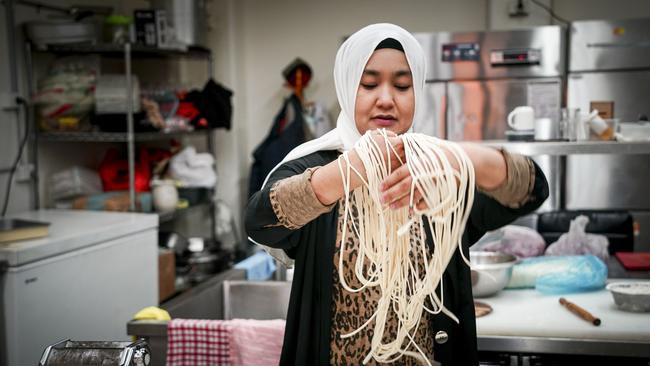SA Weekend food review: Tangritah Uyghur restaurant
A Uyghur family from northern China has brought the honest flavours of their home-style cooking to an old church in the city, writes Simon Wilkinson.

SA Weekend
Don't miss out on the headlines from SA Weekend. Followed categories will be added to My News.
This is a story of faith, a story that spans almost a century, two different continents and two different beliefs.
It begins in mid-1920s Adelaide with followers of the breakaway Church of Christ looking for a new home.
They settle on a site at 100 Grote Street and commission a handsome two-storey chapel of bluestone and brick that is completed in April 1926.
Today, while the building has changed little on the outside, it offers a very different sort of service.
Still, for the family that runs the restaurant now resident here, an unbreakable faith is crucial to who they are, how they got here and what they do.
Bahar Mamtimin and Yakub Sabir are Uyghurs, from Xinjiang in northern China, where the government has been condemned for policies aimed at repressing this ethnic minority’s Islamic religion and customs.

The couple came to Adelaide in 2007 and three years later opened the first Tangritah Uyghur Restaurant, in a humble shopfront a few hundred metres from where they have settled now.
Yakub can occasionally be seen on the footpath in front of the old church, fanning his charcoal fire and tending to a long row of lamb and chicken kebabs, but otherwise the entrance and dining space don’t give much away.
A small room with prayer mats can be seen from the front counter but elsewhere the decoration has hardly changed from the previous occupant, a Korean barbecue, down to the boughs of cherry blossom that hang above some of the booths.
Bahar and Yakub’s daughter Marhaba, who followed her parents to Australia a few years later, helps to run Tangritah.

Her quietly spoken English is excellent (even if she doesn’t believe it) as she guides us through the picture-book menu and helps to unravel the origins of Uyghur food. Much of this has to do with geography.
Xinjiang was a key point on the ancient trade routes between Europe and Asia, and is now bordered by Mongolia, Russia, India and a host of Stans. All these ingredients have bubbled away together like the ingredients in the Uyghur’s favourite lamb soup. Cumin and peppers – red, black and white – are the key flavourings, along with plenty of salt.
This region of deserts and mountains is about as far from the coast as you can get, so don’t expect seafood. And, being Muslim, there is no pork (or alcohol, for that matter).
Most meals contain halal meat, particularly lamb, and tomato-based sauces, which sounds unlikely until you discover that Xinjiang is a key supplier of tomatoes across China and around the world.
For a one-dish summary of all the above order the “laghman”, a daunting bowl of noodles that have been hand-pulled by Bahar into seemingly endless lengths that defeat the most valiant attempts to twirl them intact on to a fork.

While the thickness varies from fine spaghetti to something three times the diameter (no machines used here), the noodles have an irresistible bite that is firm without becoming chewy and soak up just enough of the mildly spicy soup/sauce. Spread across the top are pieces of lamb tossed with an array of veg including capsicum, onion, celery and a black fungus, all perfectly done. This is home cooking of the highest order.
Fried short noodles are much easier to wrangle and feature in a similar composition, this time using beef.
The “lamb pie” has the meticulously crimped rim and golden tan of prize-winning pastry but is actually made with a dough more similar to pizza or flat bread that is cooked by frying in oil. Inside is a mixture of minced meat, onion, cabbage and finely diced capsicum.
For the sake of variety, you might want your kebab to be chicken but it’s hard to beat a trio of gnarly lamb chops, impaled on twin swords, cooked until the fat has crisped and there isn’t a hint of pink, like an old school barbecue.
Fried green beans might not be a Uyghur tradition but these charred, shrivelled beauties with sesame seeds, chilli and a boot-load of garlic are up there with Chinatown’s best.
Tangritah has a few challenges on the horizon. Marhaba is a week or two from giving birth and is not sure how her mother will cope preparing all the main dishes on her own while she is away. They have pared back the menu in preparation but worry that customers might still be waiting too long on busy nights. She hopes they will be patient and show a little faith.

